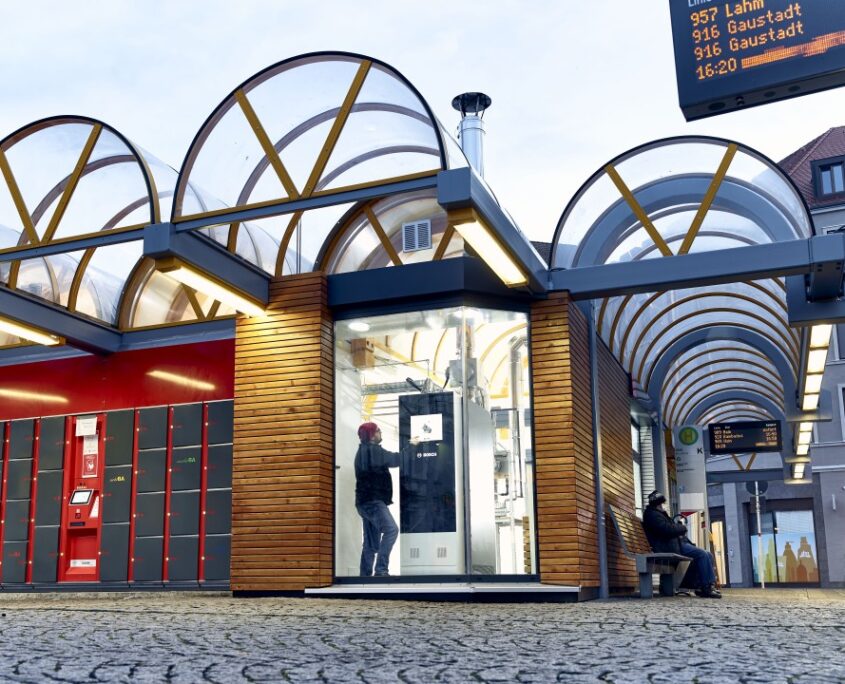- 05. 07. 2021
Climate-friendly electricity from the neighbourhood
First real operation of a stationary fuel cell from Bosch and the Bamberg public utility company
- Bosch and Stadtwerke Bamberg are producing electricity and heat for the first time with a stationary fuel cell in a city district.
- Stationary fuel cell at the central bus station in Bamberg supplies more than 20 four-person households with climate-friendly electricity.
- Heat is used for heating and hot water for an adjacent bakery.
- Bosch plans to invest a three-digit million sum in stationary fuel cells by the end of 2024.

Bamberg / Stuttgart – Together with the Bamberg municipal utility, Bosch is now demonstrating for the first time in Bamberg’s city center with its stationary fuel cell what a decentralized, climate-friendly energy supply of the future could look like. A small power plant based on a solid oxide fuel cell (SOFC) was put into operation at the central bus station (ZOB). The two-meter-high refrigerator-sized system generates around 10 kilowatts of electricity, which can cover the power needs of more than 20 four-person households in the city quarter around the bus station. With an efficiency of 60 percent for power generation and more than 85 percent for additional heat utilization, this stationary fuel cell is clearly superior to other energy converters of the same size. The heat produced is used by a bakery at the bus station for heating and hot water: “The decentralized energy supply is becoming very important with the energy transition. The stationary fuel cell is ideally suited for expanding the local supply of electricity and heat in urban neighborhoods,” reports Dr. Wilfried Kölscheid, who is responsible for stationary fuel cells at Bosch. “We are pleased to have found a partner in Stadtwerke Bamberg with whom we can jointly demonstrate what our stationary fuel cell is capable of.”
The decentralised energy supply is becoming very important with the energy transition. The stationary fuel cell is excellently suited for the expansion of local power and heat supply in urban quarters. “
Demand-driven electricity production in the urban district
The use of stationary fuel cells in an urban district is not only an important field of application for Bosch; the Bamberg municipal utility also sees the technology as a sustainable solution for supplying energy to existing buildings and developing new districts. “With the fuel cell, we will gain experience that should create sustainable benefits in the future for the energy supply of existing buildings and new quarters,” Dr. Michael Fiedeldey, Managing Director of Stadtwerke Bamberg, is certain. “At the same time, we want to make the new technology tangible for all citizens. That’s why we’re not putting it in some basement, but in the middle of the ZOB as a traffic hub for over 20,000 people a day.” As soon as the situation allows it again, the InnoLab at the bus station will be open regularly for interested guests. Experts from the companies will then be available to answer questions. For a virtual look inside the lab, visit www.stadtwerke-bamberg.de/innolab.
The SOFC plant is operated by Stadtwerke Bamberg with natural gas, is very quiet and is already suitable for hydrogen. Compared to the electricity mix in Germany, an SOFC system saves almost up to 40 percent of climate-damaging CO₂ emissions even when operated with natural gas. If the fuel cell is operated with hydrogen, there are no more direct CO₂ emissions. For cities and metropolitan areas with high energy demand, SOFC systems can therefore ensure a sustainable energy supply by allowing the output of the stationary fuel cell to be regulated according to demand. In addition, the existing gas infrastructure can be used in combination with many networked fuel cells to reduce the load on the power grid. In this way, further electricity requirements can be covered by on-site generation. The SOFC plant in Bamberg is also networked via the Bosch IoT Cloud: 20 sensors within the fuel cell continuously provide data on power production and operating status. This data also helps to further develop the technology. In the future, various stationary fuel cells can be networked with each other via the cloud solution to form virtual power plants and digitally controlled by intelligent, self-learning software – this conserves the environment and resources.
Bamberg’s mayor Andreas Starke welcomes the cooperation and the citizen-friendly installation at the Bamberg ZOB: “We are proud that Bosch and Stadtwerke Bamberg are implementing a climate-friendly and at the same time economical technology with the stationary fuel cell.
This innovative energy supply is an important building block in the transformation process of Bamberg as a business location in order to secure jobs for the future”.
Bosch to invest a three-digit million sum by the end of 2024
By the end of 2024, Bosch plans to invest a three-digit million sum in stationary fuel cells and test SOFC systems under real-life conditions. Bosch already operates more than 20 SOFC pilot plants at its locations in Bamberg, Homburg, Renningen, Schwieberdingen, Feuerbach, and Wernau. Bosch already has 250 associates at various locations working in this growing field of the future. In Bamberg alone there are already over 100 employees. The Bosch plant in Bamberg manufactures the particularly important stacks for the fuel cell systems. “We are proud that the Bamberg plant is an integral part of driving forward the pre-industrialization phase to the expected series production of the solid oxide fuel cell in 2024. Together with Stadtwerke Bamberg, we can test this pioneering innovation directly on site in real-world operations and gain important insights into its operation,” says Dr. Martin Schultz, commercial plant manager at the Bosch plant in Bamberg. Only close cooperation between the Bosch Corporate Research, Powertrain Solutions, and Thermotechnology divisions has made the development of these novel fuel cell systems possible.
CONTACT
+49 711 811-55508
doerthe.warnk@de.bosch.com
Share on the network:
